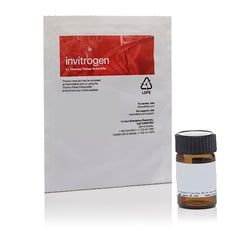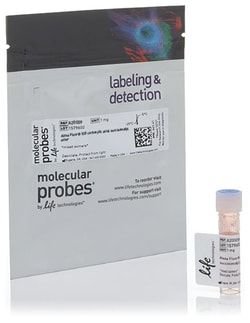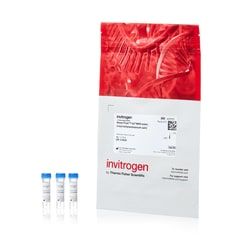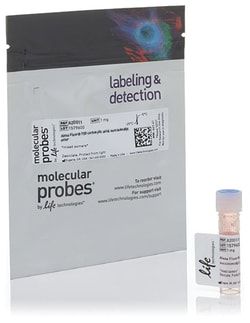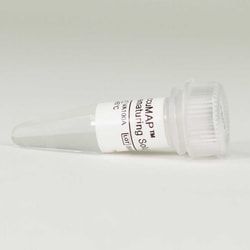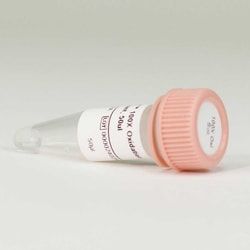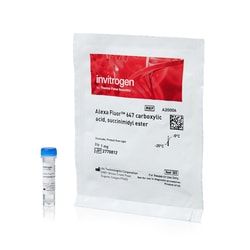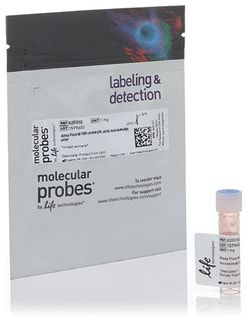7075614
Invitrogen™ Alexa Fluor™ 647 NHS Ester (Succinimidyl Ester)
Alexa Fluor™ 647 is a bright and photostable far-red dye with excitation ideally suited to the 633 nm laser line.
Manufacturer: Fischer Scientific
The price for this product is unavailable. Please request a quote
Emission
672 nm
Excitation
651 nm
Description
- Alexa Fluor™ 647 is a bright and photostable far-red dye with excitation ideally suited to the 633 nm laser line
- Used for stable signal generation in imaging and flow cytometry, Alexa Fluor™ 647 dye is water soluble and pH-insensitive from pH 4 to pH 10
- Fluorescence of this long-wavelength Alexa Fluor™ dye is not visible to the human eye but is readily detected by most imaging systems
- In addition to reactive dye formulations, we offer Alexa Fluor™ 647 dye conjugated to a variety of antibodies, peptides, proteins, tracers, and amplification substrates optimized for cellular labeling and detection
- The NHS ester (or succinimidyl ester) of Alexa Fluor™ 647 is the most popular tool for conjugating this dye to a protein or antibody
- NHS esters can be used to label to the primary amines (R-NH 2 ) of proteins, amine-modified oligonucleotides, and other amine-containing molecules
- The resulting Alexa Fluor™ conjugate will exhibit brighter fluorescence and greater photostability than the conjugates of other spectrally similar fluorophores
- Detailed information about this AlexaFluor™ NHS ester: Fluorophore label: Alexa Fluor™ 647 dye Reactive group: NHS ester Reactivity: Primary amines on proteins and ligands, amine-modified oligonucleotides Ex/Em of the conjugate: 651/672 nm Extinction coefficient: 270,000 cm -1 M -1 Spectrally similar dyes: Cy5™ Molecular weight: ∼1250 Typical Conjugation Reaction You can conjugate amine-reactive reagents with virtually any protein or peptide (the provided protocol is optimized for IgG antibodies)
- You can scale the reaction for any amount of protein, but the concentration of the protein should be at least 2 mg/mL for optimal results
- We recommend trying three different degrees of labeling, using three different molar ratios of the reactive reagent to protein
- The Alexa Fluor™ NHS ester is typically dissolved in high-quality anhydrous dimethylformamide (DMF) or dimethylsulfoxide (DMSO) (D12345), and the reaction is carried out in 0.1–0.2 M sodium bicarbonate buffer, pH 8.3, at room temperature for 1 hour
- Because the pKa of the terminal amine is lower than that of the lysine epsilon-amino group, you may achieve more selective labeling of the amine terminus using a buffer closer to neutral pH
- Consult user Manual for solubility instructions
- Conjugate Purification Labeled antibodies are typically separated from free Alexa Fluor™ dye using a gel filtration column, such as Sephadex™ G-25, BioGel™ P-30, or equivalent
- For much larger or smaller proteins, select a gel filtration media with an appropriate molecular weight cut-off or purify by dialysis
- We offer several purification kits optimized for different quantities of antibody conjugate: Antibody Conjugate Purification Kit for 0.5-1 mg (Cat
- No
- A33086) Antibody Conjugate Purification Kit for 20-50 μg (Cat
- No
- A33087) Antibody Conjugate Purification kit for 50-100 μg (Cat
- No
- A33088) Learn More About Protein and Antibody Labeling We offer a wide selection of Molecular Probes™ antibody and protein labeling kits to fit your starting material and your experimental setup
- See our Antibody Labeling kits or use our Labeling Chemistry Selection Tool for other choices
- To learn more about our labeling kits, read Kits for Labeling Proteins and Nucleic Acids—Section 1.2 in The Molecular Probes™ Handbook
- We’ll Make a Custom Conjugate for You If you can’t find what you’re looking for in our online catalog, we’ll prepare a custom antibody or protein conjugate for you
- Our custom conjugation service is efficient and confidential, and we stand by the quality of our work
- We are ISO 13485:2000 certified.
